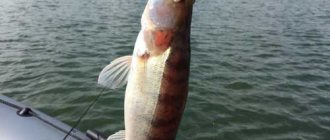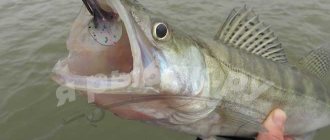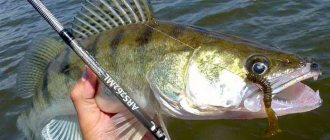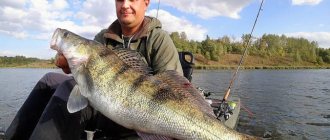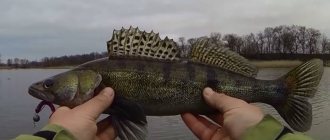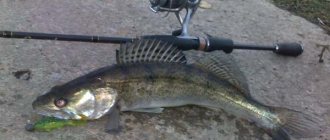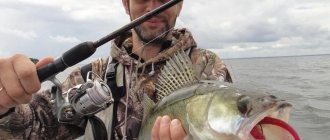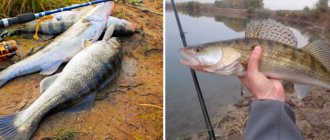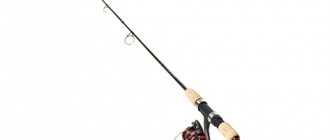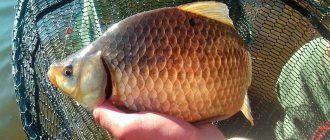When going fishing to catch pike perch using a spinning rod, you need to get to know this predator better; it would be good to know what this fish eats and when it likes to hunt. When choosing a place for spring, summer or autumn fishing, it is better to know the lifestyle of pike perch and at what time of year and with what gear and bait fishing for this predator is more successful. It is also necessary to take into account that during spawning there is a ban on catching pike perch. The ban period in spring usually lasts until the middle or end of June, the date depends on the region and the geographical location of the reservoir; spawning of the fanged predator occurs earlier to the south, and later in the northern regions.
Where to catch pike perch using a spinning rod
In the spring, successful fishing for pike perch with a spinning rod before the fishing ban occurs only in pits and pools, where there is a lot of this fish, but even here this fishing is very short-lived and lasts several days, no more than a week. It is caused by the fact that when the river opens, this predator, along with pike and large perch, and sometimes catfish, gathers from almost the entire area into the pool and feeds here on fish carried away by the flow of water. All these predators, not allowing the fish as it slides down to recover from the rapidity of its movement, grab it in flight, sometimes on the surface of the water. With such an abundance of food in the spring, pike perch are difficult to catch using spinning rods.
Catching pike perch in the summer with spinning rods, circles and nets is practiced mainly in large pools, and in general deep river holes, littered with various snags and old trees that serve as an ambush. In other places it is rarely found, although small pike perch, up to 400 grams, are sometimes caught in large numbers along with perches using a worm rod. Large pike perch is a very strong and lively fish, since it lives in even harsher places than perch, its fishing requires strong tackle, as for pike, a strong and durable spinning rod.
Catching pike perch in the summer with a spinning rod
Fishing for pike perch in the summer using spinning rods is most common on large and deep rivers that have fairly strong currents and depths reaching 8-10 meters. Pike perch prefers to stay in such places. It does not live in muddy and shallow water areas. There are, however, exceptions. In the reservoirs of the Volga cascade, where there are many flooded forests, a strange pike perch appeared, almost black in color and humpbacked, like a large humpback perch. Apparently, it has taken root in snags and at a relatively shallow depth of no more than 3.5 meters. Apparently, this is due to the depletion of small fish in the riverbed and their appearance in the grass and snags. And the predator, as you know, always comes for fry and small fish. In another case, bershi and pike perch can go to shallows and spits during the hot period of mid-summer and only at night. This is probably the only time when you can catch this predator in the shallows.
Tackle for catching pike perch in summer is much more elegant and thinner than spring and autumn gear. And the baits are smaller in size, and significantly so. This is due to the fact that the pike perch is full and cautious at this time. The main thing for reliable catching of pike perch is the sharpness and strength of the hook, since the hard mouth of a predator breaks through with great difficulty even with a strong hook, especially if the sting of the hook gets into the bony part of its mouth.
The most common baits for catching pike perch are silicone baits mounted on a jig head or offset hook. Among them, in terms of the number of bites realized, baits made of edible rubber hold the lead, since if there was a grip, then sooner or later the pike perch will be hooked. This predator likes the salty taste of edible rubber, and it will not simply let go of the bait, but will attack again and again. Small foam fish, usually about 5 cm, are also considered successful.
The peculiarity of playing with foam rubber is that they can play even without wiring, but only under the pressure of a strong current. Being almost vertical at the bottom, these baits briskly oscillate under the current and attract fish. Also, foam fish have one more additional phase of the game, if you use a weight in the form of a lentil, that is, flattened on the sides. When it falls to the bottom, the weight rises on its edge, and then falls flat. At this moment, the bait makes a kind of somersault, spinning around the load. This is where the bite often follows.
The advantages of silicone baits or edible rubber baits are that they are very active and come in a wide variety of colors. Therefore, it is best to fish with them during a good pike perch bite. Especially catchy are the so-called Manso twisters, which have a green color with shiny inclusions, as well as pearlescent white. If you look at them in expanded form, these are clearly too large baits, especially for pike perch, but, nevertheless, the fanged predator is caught very well with these large twisters, the length of which can be twelve centimeters. Various vibrotails are equally successful.
But in some cases, spinnerbaits are the most effective. For some reason, their strange design is attractive to pike perch, apparently due to the presence of two active elements on one bait. This is the petal of the “spinner” and the soft bait on the hook of the spinnerbait. Typically a twister is used. When the bite is weak, a foam fish is placed on the hook of the spinnerbait.
Various worms and Long John are also very effective. If they are mounted on an offset hook, then these are excellent non-hooking hooks.
Deep diving wobblers are also considered very successful baits. In some cases there is no alternative to them. They are especially good for the rafting method, when the bait is simply thrown downstream and then returned upstream with uneven reeling and pauses.
Catching pike perch in the summer with a spinning rod during the hot period brings success more often at night. Then minnow wobblers and narrow spoons, as well as spinners, work best. All these baits can work in the upper layers of water and in the shallowest waters, where pike perch often come out en masse on warm summer nights. Then you can hear the real fight of the pike perch chasing the fry. But it is imperative that next to such spits there is a channel hole or some kind of deep depressions where the pike perch goes for the day.
Spinning rod for pike perch for casting
You can catch pike perch using a spinning rod and cast almost all year round, even in winter, if there are open areas of water, with the exception of the ban on fishing in the spring during the spawning period. These predatory fish can live and be found both in still water and on rivers with significant currents, and also taking into account that the fish can be caught quite large, the choice of rod is varied, one for some conditions, and another for other conditions. You should choose a spinning rod for catching pike perch depending on the fishing conditions, fishing from a boat or from the shore, whether there is a current or not, and you should also choose a fishing rod taking into account the weight of the spoon, jig head, wobbler or other bait.
If you have to catch pike perch using a spinning rod while casting on a new body of water with an unknown bottom topography, it is better to have two or three spinning rods with you that are different in length, test and structure for the weight of different baits and for different retrieves. In general, catching a fanged predator using a spinning rod and casting is more interesting than passive methods of catching pike perch by trolling with a wire, or even more so by fishing with live bait.
Among fishermen who prefer casting with a spinning rod, fishing for fanged fish on a jig head using various silicone and other soft baits predominates to a greater extent. This is explained by the fact that pike perch spend most of the year, especially in summer, from the second half of summer until autumn in holes and pools at a depth near the bottom, or at the edge level. Therefore, it is better to catch it with baits passing near the bottom.
Choosing a spinning rod for jigging is a different story, as there are quite a lot of options. And yet, when fishing with jigs, it is very important that the structure and test of the spinning rod correspond to the weight of the selected bait with a jig head. In order to be able to clearly feel the movement and impacts of the bait on the bottom, and even more so to feel the bite of a predator. When fishing in a current, the weight of a jig head can be 15-30 grams, and in calm and still water, the weight of a jig can be 5-10 grams, and spinning rods should be accordingly different in test.
Pike perch is a predatory fish that, when casting from a boat or shore, actively takes both wobblers and spinners. It is better to choose a spinning rod for casting a wobbler or spinner for pike perch that is longer in order to cast the bait further, especially the wobbler. Since wobblers usually have a large windage and low weight, it can be very inconvenient to throw them, especially over long distances. And therefore, it is better to take a spinning rod for casting a wobbler with a length of 2.7-3.3 meters, medium hard and with a dough that is naturally designed for the weight of the bait.
Fishing with a retractable leash
Catching pike perch using a retractable leash is not at all difficult, as it might seem at first glance, and the result can really surprise the fisherman. The advantages of using such gear are that the bottom of the reservoir where pike perch lives is subject to various obstacles and inconveniences:
- driftwood;
- underwater rocks;
- pits;
- underwater slopes with shells.
All this increases the chances of the line breaking along with the bait. Using a diverter leash significantly reduces the chances of such a loss.
In addition, a retractable leash also has other advantages when fishing for pike perch. These include:
- reducing the chance of gear breakage and bait breakage;
- much greater freedom for the bait to play (it is in close proximity to the bottom, but does not touch it or drag along it);
- correct installation of the structure, taking into account the depth of the reservoir, allows you to fish with this type of gear both in shallow water and at depth; both in standing water and on a river with a strong current.
The design of this gear is very simple, it is presented in the form of a fishing line and a weight attached directly to it, as well as a diverter leash attached above the weight, on which the bait is held. The length of the diverter leash itself can be in the range of 70-120 cm.
Read about organizing gear here
The weight of the load is selected in accordance with the weight of the bait itself, but it should exceed its weight by 2-3 times. But the shape of this very cargo already depends on the bottom topography. Cone and pin shapes can be considered universal. Regarding modifications for fastening the diverter leash, there are a great many of them, and this is a matter of personal taste for the fisherman himself. The main methods of fastening can be considered the following:
- fastening using special swivels with carabiners;
- method of attaching a load to a swivel sliding along a fishing line;
- method of fastening equipment with a partial degree of freedom (involves threading the main cord through a swivel and hanging the load).
What baits to use for catching pike perch on a retractable leash
The main baits for catching pike perch on a retractable leash are:
- twister;
- wobblers.
Spoons are not suitable as bait for this type of gear.
You need to keep in mind that pike perch prefer bait colors such as orange, yellow and green. However, weather conditions also play a certain role in choosing the color of the bait. For example, in bad weather you should not give preference to brightly colored baits. You can choose calmer and darker shades.
Regarding the size, we can say that the size of the bait directly depends on the size of the fish that is found in the fishing area. The size of the bait can vary from 3 to 15 cm.
Next is a video with an overview of baits and tackle, as well as techniques for catching pike perch using a spinning rod.
Spinning rod equipment for pike perch
It is better to equip a spinning rod for casting pike perch with a spinning reel or a multiplier casting reel. But fishing with a baitcasting reel is more difficult, since if the settings are not correct and without experience in use, when casting, there is a high probability of a beard appearing on the reel, and then a long and tedious unraveling of the fishing line. And it is also necessary to take into account that a good quality multiplier casting reel is much more expensive than a spinning reel.
It is better to choose a spinning reel that is also durable and of high quality, size 2000-4000, depending on the test of the spinning rod and the bait. To equip the reel, you can wind a fishing line with a diameter of 0.27-0.35 mm or a cord 0.8-1.2 (0.14-0.20 mm thick), whatever is convenient for you and always taking into account the characteristics of the fishing rod.
It is better to fasten the bait to a fishing line or cord using a metal leash with a clasp. It is preferable to use a titanium leash, without memory, 15-20 cm long. Because when casting, a pike can bite and cut off your favorite and expensive wobbler or spinner with its teeth. And be sure to remember to install a swivel between the fishing line and the leash.
Choosing a spinning rod for jig fishing
Spinning for pike perch should have increased rigidity. This will allow you to make a sharp hook and cast a heavy jig bait.
- A suitable option for shore fishing would be Daiwa Whisker series rods with a length of 2.4 to 3 m.
- For fishing from a boat, spinning rods with a length of 1.8 to 2.4 m are suitable. An excellent example of such a “stick” would be Premier Graphite from St. Croix 2.1 m long.
When fishing for pike perch, both spinning reels and inertial models can be used.
Each of them has both strengths and weaknesses. The diameter of the fishing line used largely depends on the type of reel. A fishing line of 0.35-0.5 mm is wound on simple inertial reels, and 0.22-0.35 mm on spinning reels.
The peculiarity of pike perch is that it practically does not pay attention to the thickness of the fishing line, allowing you to use a fishing line of 0.6-0.7 mm when fishing in snags.
Read a detailed guide to choosing jig spinning rods.
Jig baits, wobblers and spinners for pike perch
Pike perch baits for jig heads can be varied in color, shape and weight, usually it is soft rubber made of silicone, even with a smell and edible. Rubber comes in a variety of forms, including worms, vibrating tails, twisters, crustaceans and other forms. The colors of pike perch jig rubber can work in different ways, it’s better to try options of different shapes and colors, and also a lot depends on the wiring of the jig, so the main thing when catching pike perch with a spinning rod is to hold the bait so that the predator wakes up the hunter’s reflexes and rushes after the prey.
There are also many models of zander wobblers specifically for casting, which, due to their design, fly smoothly and far, but it is not always these wobblers that end up in the fisherman’s box. If the rod is correctly selected for casting, then throwing wobblers for fishing into the line and for trolling will not be difficult. Wobblers and spinners for pike perch when casting with a spinning rod work in the same colors as when fishing by trolling, the main thing is to choose the depth of the wobbler so that the bait passes at the depth and level of the fanged fish.
Therefore, when casting, it is better to take a wobbler that is sinking or neutrally buoyant (suspending), although floating wobbler models also work when casting.
Posting bait for pike perch
When catching pike perch using a spinning rod while casting, it is necessary to take into account that in holes it usually stands 50-100 cm from the bottom or at the edge level. Therefore, when fishing with a jig bait, the wiring must be such that it does not drag along the bottom when reeling in the reel, but rises up and falls to the bottom again with a pause, then again reeling in 2-3 turns of the reel.
For such bottom bait placement, there is an original way of catching fanged and various other predatory fish, called a drop shot. In this rig, the bait is on the main line at a distance of 50-100 cm from the bottom, and the load is dragged along the bottom, retrieving in the form of a leisurely twitch. There is also a variant of gear with a retractable leash, where the bait is attached to the main line on a leash made of fishing line above the sinker, the length of the leash can be different 20-150 cm. Thus, the bait passes in the layer above the bottom, where the predator may be located, provoking him to bite.
When catching pike perch with a wobbler using a spinning rod while casting, the wobbler must also be held at the bottom in the hole or at the very edge at the exit from the hole. Since the wobbler, due to its parameters, will play itself, the wiring should be leisurely, simply working with the reel, winding the fishing line. And to make the bait look like a wounded fish, you can add movements with the rod, short hooks with the tip of the spinning rod at the surface of the water, periodically reeling in the fishing line. But you definitely need to try different retrieve speeds, since the fish may not react to a bait quietly swimming past it and the bait itself may not attract it. Therefore, it is always better to try different wobblers, spinners and different bait placements.
Hooking and landing pike perch on a spinning rod
When catching pike perch with a spinning rod, you need to hook it with a very fast, but not wide stroke. The main thing is to use a hook to pierce the cartilaginous mouth of the predator, which is not always possible when hooking. Having felt the hook, the pike perch tries to escape and go into the snags at the bottom, so in snaggy places it must be fished out quickly and not allowed to tangle the fishing line.
With a strong fishing line, there is no need to stand on ceremony with a fanged predator and you need to drag it more boldly, not allowing it to come to its senses. Then he walks briskly, only pushing as hard as he can, tugging the rod a little. A very large pike perch sometimes lies on the bottom and moves there so stubbornly that you can’t quickly drag it out of its place. In such cases, in order to stir up the predator and force it to move, it is best to tighten the fishing line and pull it in different directions.
A large pike perch must be fished out and only then reeled in, as it can easily break the fishing line, but as soon as it is taken out of the water, it is completely helpless and falls asleep very quickly. Small pike perch on a thick fishing line can be dragged directly into a boat or to the shore, since outside the water the pike perch usually does not twitch, like perch or ruff.
